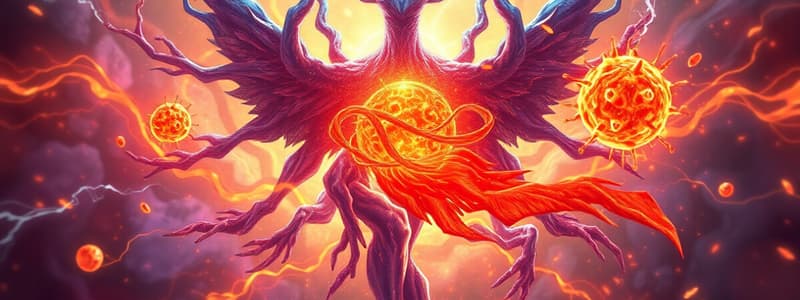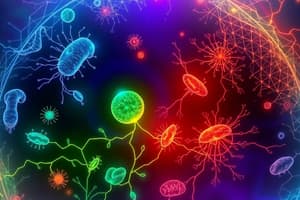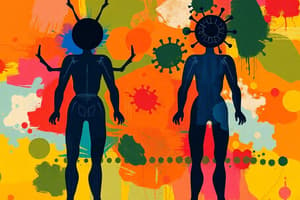Podcast
Questions and Answers
Which of the following must occur for a pathogen to cause disease in a human?
Which of the following must occur for a pathogen to cause disease in a human?
- The pathogen must be able to evade the body's defenses.
- The pathogen must be able to penetrate the surface of the body.
- The pathogen must be able to access a portal of entry into the body.
- All of the above. (correct)
How do innate and adaptive immunity work together to defend the body?
How do innate and adaptive immunity work together to defend the body?
- Innate immunity is activated only after adaptive immunity fails.
- Innate and adaptive immunity target the same pathogens, providing redundant protection.
- Innate immunity provides a rapid, nonspecific response, while adaptive immunity provides a slower, specific response; both are needed to be fully protective. (correct)
- Adaptive immunity is always the first to respond, triggering innate immunity.
Which of the following is the best definition of the body's first line of defense?
Which of the following is the best definition of the body's first line of defense?
- A series of barriers that work nonspecifically to inhibit microbes from causing infection. (correct)
- A set of specific immune responses that target particular pathogens.
- A collection of adaptive immune responses that create immunological memory.
- A series of cellular and chemical responses that occur inside the body.
What role do tight junctions play in the body's defense?
What role do tight junctions play in the body's defense?
Which of the following best describes how mucociliary movement defends the body?
Which of the following best describes how mucociliary movement defends the body?
How do lysozymes act as a chemical barrier in the body's defense?
How do lysozymes act as a chemical barrier in the body's defense?
What does 'species specificity' refer to in the context of genetic barriers?
What does 'species specificity' refer to in the context of genetic barriers?
Why are normal flora able to survive the body's first line of defense barriers?
Why are normal flora able to survive the body's first line of defense barriers?
Which type of barrier is primarily exemplified by the constant undergoing of mitosis and replacing sloughed layers?
Which type of barrier is primarily exemplified by the constant undergoing of mitosis and replacing sloughed layers?
Epithelial cells often are connected via tight junctions. What is the purpose of the tight junctions?
Epithelial cells often are connected via tight junctions. What is the purpose of the tight junctions?
Which of these is an example of a mechanical barrier deployed in the immune response?
Which of these is an example of a mechanical barrier deployed in the immune response?
When microbes are trapped and then cilia bring them up to be coughed/ swallowed, this is an example of what?
When microbes are trapped and then cilia bring them up to be coughed/ swallowed, this is an example of what?
How does your skin use keratin for defenses?
How does your skin use keratin for defenses?
How does saliva and tears function as a chemical barrier?
How does saliva and tears function as a chemical barrier?
You can be immune to certain diseases because you have a genetic advantage against them, this is known as what?
You can be immune to certain diseases because you have a genetic advantage against them, this is known as what?
The attachment which allows flora to adhere to a surface is known as what?
The attachment which allows flora to adhere to a surface is known as what?
What is the second line of defense activated by?
What is the second line of defense activated by?
The second line of defense consists of all the following except:
The second line of defense consists of all the following except:
Four signs can be used to identify inflammation, Which of the following is NOT one of them:
Four signs can be used to identify inflammation, Which of the following is NOT one of them:
What is Edema (local)?
What is Edema (local)?
Edema is also known as swelling, what are some of the disadvantages?
Edema is also known as swelling, what are some of the disadvantages?
What is the definition of chemotactic factors?
What is the definition of chemotactic factors?
Neutrophils and monocytes squeezing between cells of vessel wall is known as what?
Neutrophils and monocytes squeezing between cells of vessel wall is known as what?
What 5 stages describe phagocytosis?
What 5 stages describe phagocytosis?
Your body increases its temperature when you have a fever because it intends to do what?
Your body increases its temperature when you have a fever because it intends to do what?
Interferons' functions include:
Interferons' functions include:
Complement's Three Primary Effects include:
Complement's Three Primary Effects include:
Which best defines innate barriers?
Which best defines innate barriers?
First must do what to cause disease?
First must do what to cause disease?
The body's first line of defense is best described as which:
The body's first line of defense is best described as which:
What type of barrier is HCL?
What type of barrier is HCL?
During a fever what type of chemical is released to try and fight of pathogen?
During a fever what type of chemical is released to try and fight of pathogen?
What produces redness during vascular changes?
What produces redness during vascular changes?
Some microbes can produce surface proteins, why is producing surface proteins beneficial to the pathogen?
Some microbes can produce surface proteins, why is producing surface proteins beneficial to the pathogen?
What is the first stage of phagocytosis?
What is the first stage of phagocytosis?
When the lysosome fuses with the phagosome what does this create?
When the lysosome fuses with the phagosome what does this create?
What is a purpose of vascular changes during inflammation?
What is a purpose of vascular changes during inflammation?
What inhibits the growth of pathogens in sweat glands?
What inhibits the growth of pathogens in sweat glands?
Flashcards
Pathogen Impact
Pathogen Impact
Numerous pathogens can cause disease in humans, requiring access, penetration, and evasion.
Pathogen Entry Steps
Pathogen Entry Steps
First must access a portal of entry, then penetrate the surface - enter cells/blood, then evade the body's defense.
Innate Immunity
Innate Immunity
Present at birth, nonspecific, and lacks memory. Includes the first and second lines of defense.
Adaptive Immunity
Adaptive Immunity
Signup and view all the flashcards
First Line of Defense
First Line of Defense
Signup and view all the flashcards
Structural Barriers
Structural Barriers
Signup and view all the flashcards
Mechanical Barriers
Mechanical Barriers
Signup and view all the flashcards
Chemical Barriers
Chemical Barriers
Signup and view all the flashcards
Genetic Barriers
Genetic Barriers
Signup and view all the flashcards
Adhesins Role
Adhesins Role
Signup and view all the flashcards
Second Line of Defense
Second Line of Defense
Signup and view all the flashcards
Inflammation
Inflammation
Signup and view all the flashcards
Vascular Changes
Vascular Changes
Signup and view all the flashcards
Chemotaxis Function
Chemotaxis Function
Signup and view all the flashcards
Diapedesis
Diapedesis
Signup and view all the flashcards
Phagocytosis
Phagocytosis
Signup and view all the flashcards
First two Steps of Phagocytosis
First two Steps of Phagocytosis
Signup and view all the flashcards
Last Three Steps of Phagocytosis
Last Three Steps of Phagocytosis
Signup and view all the flashcards
Fever Induction
Fever Induction
Signup and view all the flashcards
Interferon Function
Interferon Function
Signup and view all the flashcards
Complement System
Complement System
Signup and view all the flashcards
Study Notes
Overview of Body Defenses
- Pathogens can cause disease in humans
- Pathogens must access a portal of entry to cause disease
- Pathogens must also penetrate the surface and evade the body's defense
- The body has two broad categories of defense, Innate and Adaptive
- Innate defense does not have memory and is nonspecific and present at birth
- Adaptive defense has memory and is specific
- Innate and Adaptive defenses happen at the same time to be fully protective
- The body has 3 lines of defense:
- First line is Innate barriers
- Second line is Innate Immune Response
- Third line is Adaptive Immune Response
The Body's First Line of Defense
- The environment inhibits on the surface inhibit microbes from causing infection
- Barriers are nonspecific and serve as the first line of defense
- These are barriers to prevent microbes causing disease
- Nutrients, temp, pH etc are barriers
- Structural barriers are a type of the first line of defense
- Epithelium is found on the surface both internally and externally
- Skin and Mucous Membranes are the two types of epithelial surfaces
- The epithelium is constantly undergoing mitosis, replacing layers that are sloughed
- Microbes attached to the epithelium are lost
- There are tight junctions between epithelial cells
- Mechanical barriers physically remove microbes, and involve movement
- Mucociliary movement is found lining nose and throat
- Microbes are trapped in mucus and then cilia bring it up to be coughed/swallowed
- Fluid movement is when the flow of urine/saliva/tears helps continually flush microbes from the surface
- Chemical barriers are Agents produced by the cells on the surface
- Keratin keeps the skin dry, waterproofs the skin
- Perspiration is secreted by sweat glands and the salt inhibits the growth of pathogens
- Lysozymes are made by saliva and tears and are antibacterial
- Sebum is secreted by sebaceous (oil) glands and lowers skin pH to a level inhibitory to many bacteria
- Lowering the pH to be HCL in the stomach is a chemical barrier
- Genetic barriers are when;
- Host is genetically immune to diseases of other hosts
- Microbe doesn't have the appropriate receptors or the ability to attack host cells
- Lack of receptors is also known as Species Specificity
- Examples are: HIV versus FIV, Ebola virus, and Heartworms
- Normal flora survives these barriers because they have adjustments to attach/adhere to the surface
- Attachment is with Adhesins
- Adhesins bind to their complementary receptor molecules with lock and key type fit
Practice Examples
- Salt is integument/chemical barrier
- Lysozymes are respiratory/Chemical barrier
- Mucociliary movement is a respiratory/mechanical barrier
- HCL is a digestive/chemical barrier
- Urine is a urinary/chemical barrier
- Mitosis is a intestinal/structural barrier
- Pinworms is a intestinal/genetic barrier
- Vomiting is a digestive mechanical barrier
- Structural barriers location: Mouth, Nose, Skin, Intestinal tract, Urinary tract, Reproductive tract
The Body's Second Line of Defense
- The second line of defense occurs when pathogens penetrate the skin or mucous membranes
- The second line of defense is nonspecific, and is still part of the innate immune response
- The second line of defense Consists of 4 components which each has some involvement with the blood:
- Inflammation
- Phagocytosis
- Interferon
- Complement
- Inflammation "itis" is a Nonspecific response to tissue damage from various causes (trauma, wound, burn)
- The goals of inflamation is to remove agent causing inflammation, to keep damage local, and allow for healing to occur
- Inflammation is Characterized by redness, heat, swelling, and pain
- 5th sign of inflammation is the loss of function (pain/swelling)
- Following injury there are 3 sequential events in Inflammation:
- Vascular changes
- Edema (local)
- Fever (systemic)
- Vascular changes occur when many chemicals are released triggering dilation
- Bradykinins, Prostaglandins, and Histamine trigger dilation
- Vasodilation produces redness and localized heat associated with inflammation
- Vascular changes also Delivers blood clotting proteins to site of injury as well as leukocytes
- Edema (swelling) occurs when some of the same chemicals lead to increased permeability, and increased pressure due to more blood
- Swelling dilutes toxins
- Swelling applies pressure to nearby nerves
- During Inflammation, the combonation of Neutrophils and monocytes are delivered to the site of infection
- Neutrophils and monocytes are Recruited by chemotactic factors
- Squeeze between cells of vessel wall and enter site of infection, this is Diapedesis
- Phagocytosis occurs allowing for tissue repair and removal of pathogen (if present)
- Neutrophils and monocytes are Recruited by chemotactic factors
- Phagocytosis is a process where Cells capable of phagocytosis engulf foreign material
- The Process can be divided into five stages:
- Chemotaxis- recognition of invader due to signal molecules on the microbe surface
- Ingestion- membrane extensions surround microbe forming a phagosome
- Fusion- lysosome fuses with phagosome creating a phagolysosome
- Killing- digestive enzymes in lysosome destroy microbe
- Elimination- debris discharged out of cell
- Fever is a Systemic factor that only occurs if microbe is present
- Fever results when pyrogens trigger the hypothalamus to increase the body's core temperature
- Has an impact on the Prostal gland in the brain
- There are Various types of pyrogens
- Bacterial toxins (exogenous)
- Released by phagocytes (endogenous)
- Fever makes environment less hospitable for the pathogen (inhibit growth of microbe, enhance phagocytosis)
- Chemical Defenses use interferon, which is protein molecules released by host cells to nonspecifically inhibit the spread of viral infections
- Interferon Usually works by inhibiting reproduction of the virus
- Interferon is Released by a cell once infected to protect neighboring cells
- Chemical Defenses use complement
- Complement is a Set of serum proteins designated numerically according to their order of discovery
- Complement will have 3 primary effects:
- Inflammation
- Opsonization
- MAC/Cytolysis
- Some microbes produce surface proteins that interfere with direct contact with phagocytes (either due to similarity to host or by blocking receptors)
- These surface proteins can be unique however and allow for attack by the Third Line of Defense
Studying That Suits You
Use AI to generate personalized quizzes and flashcards to suit your learning preferences.




